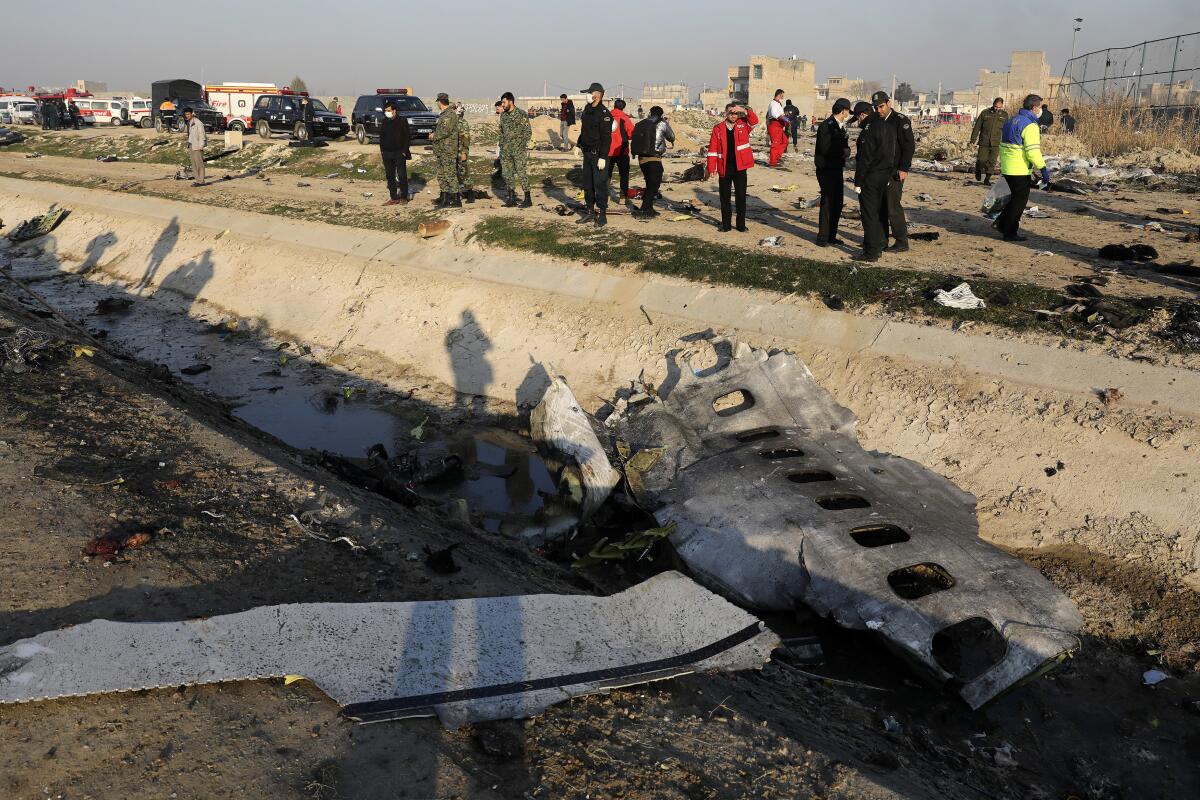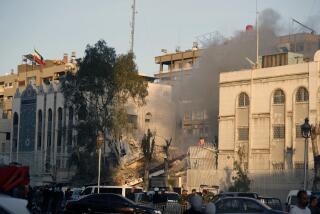Suleimani’s death stifled rebellion in Iran. But a downed jetliner reignites dissent

Hours after Iranian officials admitted responsibility for the deaths of 176 people who were aboard the Ukrainian International Airlines jetliner that crashed on the outskirts of Tehran early Wednesday, protesters took to the streets in cities across Iran on Saturday, expressing outrage at the tragedy the military said stemmed from a ghastly misunderstanding.
Just days earlier, Iranians had mourned in solidarity after a targeted U.S. drone strike ordered by President Trump killed celebrated Iranian Gen. Qassem Suleimani. But the admission that the Islamic Revolutionary Guard Corps had fired the missile that killed all aboard a commercial air flight, many of them Iranian, brought swift new calls for government reform.
“This is an unprecedented moment in the history of the Islamic Republic,” said Milad Odabaei, a scholar of Iran at Montreal-based McGill University. “Traditionally it uses external threats to create national unity and push away dissent.”
“Now, [Iran] has to play a tightrope, and is unable to gain the trust of the public and gather legitimacy. Its ability to draw on international hostility to create a national front is radically limited.”
During a deeply remorseful news conference early Saturday, Iran’s Islamic Revolutionary Guard Corps’ aerospace commander Amir Ali Hajizadeh said the shootdown took place when Iran’s air defense system was on high alert after Iran had fired missiles at military bases in Iraq in retaliation for the American strike that killed Suleimani.
The operator of the air defense system was told that “American cruise missiles had been fired [toward sites in Iran],” Hajizadeh explained, adding that the jetliner was then mistakenly identified as an enemy missile.
“He had 10 seconds to decide to fire or not and, unfortunately, took the bad decision of firing and hit the plane,” Hajizadeh said.
“I wish I had died,” said the commander, in tears. “And I wouldn’t have seen such an incident.”
Suleimani’s slaying had followed a series of November protests across Iran after a sudden announcement of a large hike in gasoline prices.
Hundreds of demonstrators were killed by security forces during those protests, in which demonstrators called for the resignation of the country’s top leaders.
The general’s slaying initially appeared to stifle the momentum for rebellion. But Saturday’s news may have inadvertently provided people with a growing impetus to begin the protests anew.
Demonstrations quickly took hold outside several universities in Tehran, including Amirkabir University and Sharif University. Several students who perished on Wednesday’s flight had been alumni, and many of the passengers aboard the plane were Iranian graduate students studying in Canada.
Samira Heshemi, a 27-year-old Tehran-based writer, was among the hundreds of people who took part. For her, being able to shout and express her anger alongside fellow citizens was cathartic, she said.
Heshemi said the events that have unfolded over the last week had already ushered in a mixed bag of emotions. Word that it was the Iranian military that downed the jetliner was painful for her; she had already been upset that Suleimani’s slaying had drowned out cries for justice for the deaths of protesters in November.
“Many people stopped [railing against] our government and started supporting it to stop a war. I’m angry about it and sad that Suleimani’s death overshadowed the death of protesters,” she said during a phone interview.
According to the New York-based nonprofit Center for Human Rights in Iran, at least 304 people, including 12 children, were killed during the unrest that shook Iran in November. The group also said up to 7,000 protesters were arrested.
Iranians at once have been faced with an increasingly closed off social and political landscape. President Trump’s sanctions campaign has wreaked havoc on Iran’s economy since the president withdrew from an international nuclear development deal with Iran in May 2018.
The inflation rate in Iran skyrocketed to 40% in the 12 months that ended Dec. 22, according to Iran’s Statistical Center. The most significant price hike that the center reported was in the agricultural sector and transportation sector. In 2019, the value of Iran’s currency plummeted, and according to the International Monetary Fund, Iran’s GDP contracted 9%.
For Bita Nejati, a manager at Mehrafarin — a charity that focuses on youth, homelessness and mental health — news that Iran was responsible for the deaths of the 176 people aboard the plane was difficult to digest. Many Iranians, including Nejati, had already been expressing disappointment behind closed doors at the Islamic Republic over its handling of the economic problems.
“Life is very expensive. We work more and get less money and everything is expensive and most of the people are struggling,” she said at home in Tehran late Saturday.
Videos circulating on social media Saturday appeared to show protests growing larger and spreading to different cities, including Isfahan, Ahvaz, Hamadan and Sari.
In Tehran, protesters called Supreme Leader Ayatollah Ali Khamenei a murderer, yelling that his government was “void.” Some chanted “death to velayate faqih” — the guardianship of religious jurists, which places Khamenei as an infallible spiritual guide hovering above the political structure.
Crowds also clapped in unison to chants of “We don’t want an Islamic Republic.”
Some videos posted Saturday showed Iranian authorities firing tear gas at activists. As the crowds dispersed, they shouted at the police, calling them “dishonorable.”
Outside Amirkabir University of Technology, throngs of people stood shoulder-to-shoulder under a bridge, pumping their fists as they shouted an oft-repeated rallying cry, “Mikosham, mikosham, an ke baradaram kosht” or “I will kill those who killed my brother.”
In a statement, the university’s students said they “had not finished mourning the martyrs of last fall and now we are confronted with the loss of those who were killed during the burial of Suleimani in Kerman and those who were killed in the plane crash.”
“Today evil has surrounded us from every direction,” the statement said.
At Sharif University, which lost graduate students in the plane crash, crowds called for a referendum to lead the way to a new government. In Isfahan, videos showed demonstrators chanting, “They’re lying when they say it’s America. Our enemy is right here.”
From his house arrest in Iran, Mehdi Karroubi, a leader of the opposition Green Movement sparked by a disputed presidential election in 2009, called on Khamenei to resign and accused him of lacking the qualifications needed to lead the nation.
Karroubi questioned whether Khamenei knew the plane was shot down as early as Wednesday, and asked why there had been a delay in notifying the public about the reasons for the crash, according to a letter posted on Saham News.
Anger was also expressed Saturday in Ukraine, where President Volodymyr Zelensky said the crash investigation should continue and the “perpetrators” should be brought to justice. He said Iran should compensate victims’ families, and he requested “official apologies via diplomatic channels.”
Ukrainian political scientist Taras Berezovets said that Iran “was pressed to acknowledge the guilt” only as a result of satellite data and over evidence “presented collectively by the U.S.A., Canada, Great Britain and others.”
On Twitter, Trump wrote Saturday, “The government of Iran must allow human rights groups to monitor and report facts from the ground on the ongoing protests by the Iranian people. There can not be another massacre of peaceful protesters, nor an internet shutdown. The world is watching.”
On social media, Iranian students called for a rally Sunday at Tehran’s Azadi Square. According to several interviews with people in Tehran, protests are also scheduled to take place Sunday in a handful of other cities.
Mahsa Alimardani, a doctoral student at Oxford’s Internet Institute, who focuses on political communication online in Iran, said Saturday that she has heard from people inside Iran that there have already been pockets of internet disruption — though it is too early to compare these protests to the ones that spread through Iran in November, she said.
“I would give it 24 hours to see whether they cut off internet again, but they have a lot to lose if they do,” she said. “It will likely further inflame the protests and the grievances against them if they cut it off.”
Hadi Ghaemi, executive director of the Center for Human Rights in Iran, said Saturday’s protests reflect the “deep dissatisfaction and discontent” signaled in the November protests.
“The events around the shooting down of the airplane has certainly reconfirmed a cycle of lies, incompetence and cover-ups that Iranian people suffer from every day,” Ghaemi said. “Now it’s on the international stage for everyone to see.”
Times staff writer Nabih Bulos in Baghdad and special correspondent Sergei L. Loiko in Kyiv, Ukraine, contributed to this report.
More to Read
Start your day right
Sign up for Essential California for news, features and recommendations from the L.A. Times and beyond in your inbox six days a week.
You may occasionally receive promotional content from the Los Angeles Times.








